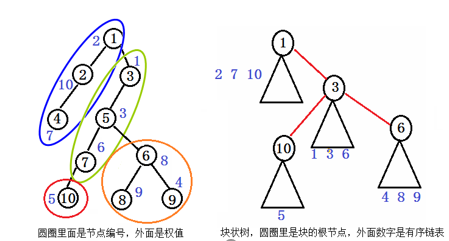Gty的妹子树
我曾在弦歌之中听过你,
檀板声碎,半出折子戏。
舞榭歌台被风吹去,
岁月深处尚有余音一缕……
Gty神(xian)犇(chong)从来不缺妹子……
他来到了一棵妹子树下,发现每个妹子有一个美丽度……
由于Gty很哲♂学,他只对美丽度大于某个值的妹子感兴趣。
他想知道某个子树中美丽度大于k的妹子个数。
某个妹子的美丽度可能发生变化……
树上可能会出现一只新的妹子……
维护一棵初始有n个节点的有根树(根节点为1),树上节点编号为1-n,每个点有一个权值wi。
支持以下操作:
0 u x 询问以u为根的子树中,严格大于x的值的个数。(u^=lastans,x^=lastans)
1 u x 把u节点的权值改成x。(u^=lastans,x^=lastans)
2 u x 添加一个编号为"当前树中节点数+1"的节点,其父节点为u,其权值为x。(u^=lastans,x^=lastans)
最开始时lastans=0。
Input
输入第一行包括一个正整数n(1<=n<=30000),代表树上的初始节点数。
接下来n-1行,每行2个整数u,v,为树上的一条无向边。
任何时刻,树上的任何权值大于等于0,且两两不同。
接下来1行,包括n个整数wi,表示初始时每个节点的权值。
接下来1行,包括1个整数m(1<=m<=30000),表示操作总数。
接下来m行,每行包括三个整数 op,u,v:
op,u,v的含义见题目描述。
保证题目涉及的所有数在int内。
Output
对每个op=0,输出一行,包括一个整数,意义见题目描述。
Sample Input
2
1 2
10 20
1
0 1 5
Sample Output
2
Sol:
首先DFS,对于每个节点,如果这个节点的父亲节点所在块未满,就塞进父节点所在块中,否则自成一块,每一块记录块的根节点,然后与父节点所在的块的根节点连边 。

我们记录每个节点所属的块,即块的根节点,建立两个图:一个图存原树(双向边),一个图存块的连通性(单向边)。
我们维护块内的元素有序,可以用链表。
如果一个节点是第一个加入块的,那么不会有别的子树的节点属于这个块,那么我们在查询一个子树时,只需要从子树的根开始向下遍历,先处理这些不在完整块内的点,一旦我们碰到了别的块内的点,就立即转移到块的图上去跑。
例如查询5,6:5不是块的根节点,所以查询单个节点5,再查询单个节点7,再查询节点6,发现6是块的根节点,可以在用二分法在块有序链表找到>6的节点个数,再查询节点10,发现10也是块的根节点

1 2 3 4 5 6 7 8 9 10 11 12 13 14 15 16 17 18 19 20 21 22 23 24 25 26 27 28 29 30 31 32 33 34 35 36 37 38 39 40 41 42 43 44 45 46 47 48 49 50 51 52 53 54 55 56 57 58 59 60 61 62 63 64 65 66 67 68 69 70 71 72 73 74 75 76 77 78 79 80 81 82 83 84 85 86 87 88 89 90 91 92 93 94 95 96 97 98 99 100 101 102 103 104 105 106 107 108 109 110 111 112 113 114 115 116 117 118 119 120 121 122 | #include <cmath>#include <cstdio>#include <vector>#include <algorithm>using namespace std;const int N=100005;int n,m,k,ans;int size[N],w[N],top[N];vector<int>list[N];inline int read()//快速读入 {char ch=getchar(); int x=0,f=1; while (ch<'0'||ch>'9') {if(ch=='-')f=-1; ch=getchar();} while (ch>='0'&&ch<='9') {x=x*10+ch-'0'; ch=getchar();} return x*f;}struct Node{int head[N],v[N],nxt[N],tot; void add(int x,int y) { v[++tot]=y;nxt[tot]=head[x];head[x]=tot; }}Map,Block,Link;void dfs(int u,int f)//一遍DFS,分块 { int root=top[u];//top[u]记录u所在块的根节点 list[root].push_back(w[u]);//同一块内的节点权值放入一个链表中 for (int i=Map.head[u];i;i=Map.nxt[i]) { if (Map.v[i]==f) continue; Block.add(u,Map.v[i]);//记录u到v的单向边 if (size[root]<k)//当前块的节点个数未满 size[root]++,top[Map.v[i]]=root; else Link.add(root,Map.v[i]);//Link记录块的根节点之间的关系 dfs(Map.v[i],u); }}void query_block(int u,int x){if (u==top[u])//整块查询 { ans+=list[u].end()-upper_bound(list[u].begin(),list[u].end(),x);//二分法在块的有序链表中查询>x的节点个数 for(int i=Link.head[u];i;i=Link.nxt[i]) query_block(Link.v[i],x); } else//块中零散节点查询 { if (w[u]>x) ans++; for(int i=Block.head[u];i;i=Block.nxt[i]) query_block(Block.v[i],x); }}void Init(){ int u,v,i; n=read(); k=(int)sqrt(n); for(i=1;i<n;i++) { u=read(); v=read(); Map.add(u,v); Map.add(v,u); } for(i=1;i<=n;i++) w[i]=read(), top[i]=i, size[i]=1; dfs(1,0); for(i=1;i<=n;i++) if(top[i]==i) sort(list[i].begin(),list[i].end());//同一块内的节点权值链从小到大排序 }void Work(){int opt,u,x,tp,last=0; m=read(); while (m--) {opt=read(),u=read()^last,x=read()^last; if(opt==0) { ans=0; query_block(u,x); printf("%d\n",last=ans); } else if(opt==1) // 把u节点的权值改成x { tp=top[u]; list[tp].erase(lower_bound(list[tp].begin(),list[tp].end(),w[u])); list[tp].insert(lower_bound(list[tp].begin(),list[tp].end(),x),x); w[u]=x; } else { w[++n]=x; tp=top[u]; Block.add(u,n); if (size[tp]<k)//块中节点个数不满 {top[n]=tp; size[tp]++; list[tp].insert(lower_bound(list[tp].begin(),list[tp].end(),x),x); } else//块中节点个数满了 {top[n]=n; size[u]=1; list[n].push_back(x); Link.add(tp,n); } } }}int main(){ Init(); Work(); return 0;} |



【推荐】编程新体验,更懂你的AI,立即体验豆包MarsCode编程助手
【推荐】凌霞软件回馈社区,博客园 & 1Panel & Halo 联合会员上线
【推荐】抖音旗下AI助手豆包,你的智能百科全书,全免费不限次数
【推荐】博客园社区专享云产品让利特惠,阿里云新客6.5折上折
【推荐】轻量又高性能的 SSH 工具 IShell:AI 加持,快人一步